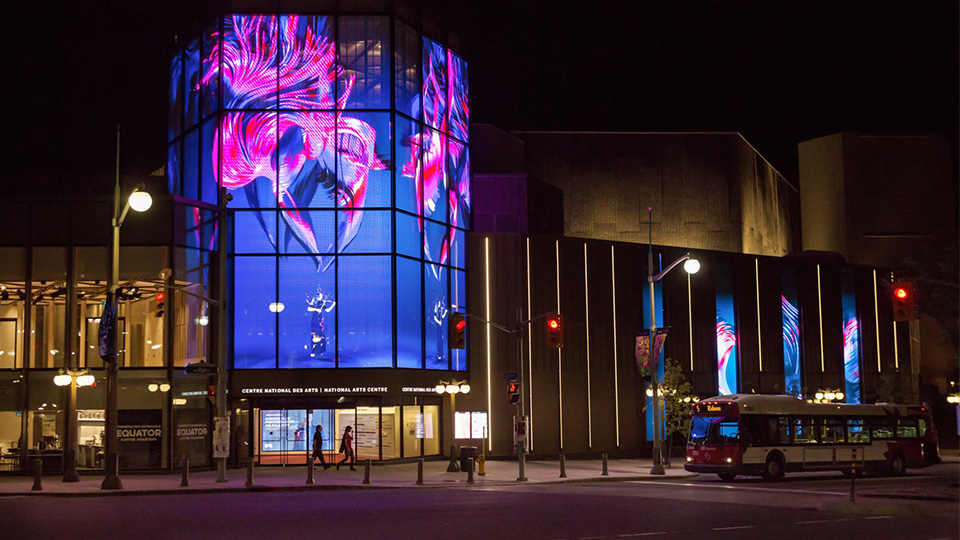
Composition of full-color LED screen
Introduction:
In a city, whether it is a large city or a small and medium-sized city, we can often see LED full color screens. Especially in urban commercial centers, whether in or outside shopping malls, tall LED full color screens are everywhere, and have even become a symbol of the city center. Because of this, more and more people want to know about full color LED screens, because it is crucial to choose what kind of media to promote their brand or service. Therefore, this article will introduce the composition of the full color LED screen in detail, and explain how its various components work together to create a colorful dynamic display effect.

What is a full color LED screen?
The full color LED screen is made up of many individual modular LED displays. Since LED displays can be seamlessly spliced, the entire large screen looks like a whole, and each LED display is composed of LED modules, control systems, LED cabinets, power supplies, and electronic components. Cabinet materials include iron, aluminum, die casting aluminum, magnesium alloy, carbon fiber, etc. Among them, iron and die-cast aluminum are the most commonly used LED display cabinets. LED full color screens are widely used in advertising, stadiums, and stage events. Their high brightness, bright colors, and energy-saving characteristics make them ideal for indoor and outdoor use.

Composition of a full color LED screen
The composition of a full color LED screen can be divided into several key components:
LED module
Each LED module consists of multiple pixels, which are usually arranged in a grid. Each pixel contains three LED diodes – red, green, and blue. By mixing the three main colors of light with different brightness, a full color display is achieved. The resolution of the LED screen depends on the size and number of pixels in each module, which also affects the sharpness and quality of the image.


Control system
The control system is the heart of an LED display. It receives input from a video source such as a computer, media player or camera and processes the data to determine the color and brightness that each pixel should display. Advanced control systems are usually divided into synchronous control and asynchronous control, which can enable real-time adjustments and dynamic content updates.
Power supply
LED screens require constant power supply to maintain brightness and performance. High-quality power supply units (PSUs) are essential for stable operation and energy efficiency. PSUs convert the input voltage to the specific requirements of LED modules.
LED display cabinets
The LED modules are installed in the LED display cabinet, which acts as a structural frame to hold multiple modules together and protect the modules and wiring from environmental factors for easy maintenance. For larger LED displays, multiple cabinets can be spliced together into a seamless display.
Heat dissipation system
LED displays generate heat during continuous operation, so an effective heat dissipation system is important to prevent overheating, which can affect the display and shorten the lifespan of components. Many high-performance screens are equipped with fans or heaters to keep the system cool.
How to generate color on LED screens
The full-color LED screen produces colors through additive color mixing. Each pixel combines red, green, and blue LEDs at varying intensities to create a specific color. For example:

When all three LEDs are at full brightness, they produce white light.
When only red and green are illuminated, the pixel appears yellow.
By adjusting the brightness of each LED diode, any color in the visible spectrum can be achieved.
Advantages of full color LED screen
Full-color LED screens offer many advantages:
Brightness and Visibility: These screens are bright enough for outdoor use, even in direct sunlight.
High Contrast and Color Quality: LED technology provides vivid colors and sharp contrast.
Long Lifespan and Durability: LED displays are energy-efficient and durable, with a longer operational lifespan than many traditional display technologies.
Full color LED display applications
Due to its versatility and influence, the full color LED screen is widely used in a variety of applications, including:
Advertising billboards: Large LED screens attract attention with high resolution visuals, ideal for outdoor advertising.
Stadiums and arenas: LED screens display live action shots and scores in real time.
Stage and Event Backgrounds: Concerts and events use LED screens to create dynamic, immersive backgrounds.


Conclusion
Under the current economic conditions, the application field of full color LED screen is extremely broad. According to its application field, it can be divided the into outdoor LED full color dispaly and indoor LED full color display.
Outdoor full color LED display: Due to the long distance of outdoor viewing, LED displays with a large pixel pitch (e.g. P10, P8, P6, P5, etc.) are usually selected, so that there is no grainy feeling when viewing.
Indoor full color LED display: In general, indoor viewing distances are relatively close and the size is relatively small, so it is more appropriate to choose a small-pitch LED display.
By knowing the details above about full-color LED screens, we can gain insight into why they are so popular in today’s industries. Whether in advertising, entertainment or public information, these screens continue to change the way we experience digital content.